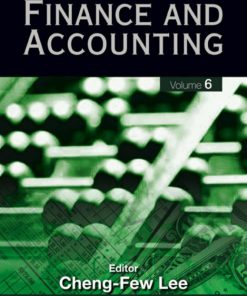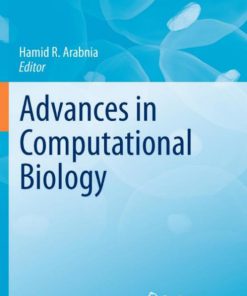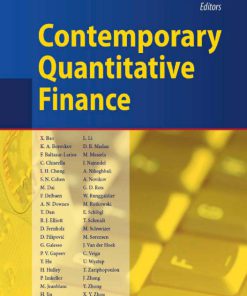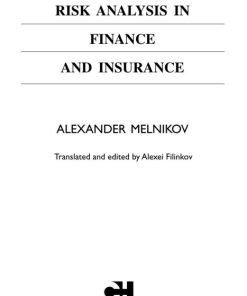Advances In Quantitative Analysis Of Finance And Accounting Vol 3 Essays In Microstructure In Honor Of David K Whitcomb 1st Edition by Ivan E Brick, Tavy Ronen, Lee Cheng Few ISBN 9812707298 9789812707291
$50.00 Original price was: $50.00.$25.00Current price is: $25.00.
Authors:Ivan E. Brick, Tavy Ronen; Cheng-Few Lee , Series:Management [649] , Author sort:Ivan E. Brick, Tavy Ronen & Lee, Cheng-Few , Languages:Languages:eng , Published:Published:Jan 2007 , Publisher:World Scientific
Advances In Quantitative Analysis Of Finance And Accounting Vol 3 Essays In Microstructure In Honor Of David K Whitcomb 1st Edition by Ivan E Brick, Tavy Ronen, Lee Cheng Few – Ebook PDF Instant Download/Delivery. 9812707298, 9789812707291
Full download Advances In Quantitative Analysis Of Finance And Accounting Vol 3 Essays In Microstructure In Honor Of David K Whitcomb 1st Edition after payment
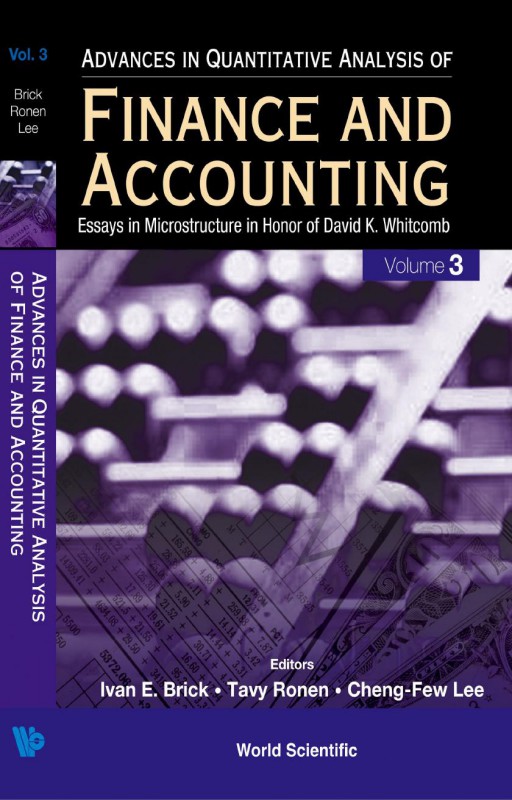
Product details:
ISBN 10: 9812707298
ISBN 13: 9789812707291
Author: Ivan E Brick, Tavy Ronen, Lee Cheng Few
News Professor Cheng-Few Lee ranks #1 based on his publications in the 26 core finance journals, and #163 based on publications in the 7 leading finance journals (Source: Most Prolific Authors in the Finance Literature: 1959-2008 by Jean L Heck and Philip L Cooley (Saint Joseph’s University and Trinity University). Market microstructure is the study of how markets operate and how transaction dynamics can affect security price formation and behavior. The impact of microstructure on all areas of finance has been increasingly apparent. Empirical microstructure has opened the door for improved transaction cost measurement, volatility dynamics and even asymmetric information measures, among others. Thus, this field is an important building block towards understanding today’s financial markets. One of the pioneers in the field of market microstructure is David K Whitcomb, who retired from Rutgers University in 1999 after 25 years of service. David generously funded the David K Whitcomb Center for Research in Financial Services, located at Rutgers University. The Center organized a conference at Rutgers in his honor. This conference showcased papers and research conducted by the leading luminaries in the field of microstructure and drew a broad and illustrious audience of academicians, practitioners and former students, all who came to pay tribute to David K Whitcomb. Most of the papers in this volume were presented at that conference and the contributions to this volume are a lasting bookmark in microstructure. The coverage of topics on this volume is broad, ranging from the theoretical to empirical, and covering various issues from market architecture to liquidity and volatility.
Advances In Quantitative Analysis Of Finance And Accounting Vol 3 Essays In Microstructure In Honor Of David K Whitcomb 1st Table of contents:
Section I — Economics of Limit Orders
Chapter 1 Discriminatory Limit Order Books, Uniform Price Clearing and Optimality Lawrence R. Gloste
1. Introduction
2. The Economic Setting
3. Optimum Terms of Trade
4. Discriminatory CLOB and Uniform Price Clearing
4.1. CLOB
4.2. Uniform price clearing
4.3. Welfare analysis
5. Discussion
6. Conclusion
Acknowledgments
References
Chapter 2 Electronic Limit Order Books and Market Resiliency: Theory, Evidence, and Practice Mark Co
1. Introduction
2. Theory
2.1. Model framework
2.2. Liquidity dynamics
3. Empirical Results
3.1. Institutional details
3.2. Data
3.3. Liquidity metrics
3.4. Realized price impact costs
4. Dynamics of Liquidity
4.1. Identification
4.2. Specification and estimation of market liquidity dynamics
4.3. Impulse response functions
4.4. The dynamic relationship between liquidity and volatility
5. Practical Issues
5.1. Institutional trading
5.2. Optimal trading strategies
5.3. Market structure, trading protocols, and resiliency
6. Conclusion
Acknowledgments
References
Chapter 3 Notes for a Contingent Claims Theory of Limit Order Markets Bruce N. Lehmann
1. Introduction
2. Limit Orders as Order Flow Derivatives
3. Limit Order Valuation and Order Flow Bets
4. Limit Order Book Dynamics
5. Conclusion
Acknowledgments
References
Chapter 4 The Option Value of the Limit Order Book Alex Frino, Elvis Jarnecic, Thomas H. McInish
1. Introduction
2. The ASX Market Structure
3. Data and Methodology
3.1. Databases and sample selection
3.2. Reconstruction of the limit order schedule
3.3. Calculation of variables and the option value of a limit order
3.4. The limit order schedule and its option value
4. Empirical Results
4.1. An intraday examination of the limit order schedule
4.2. Robustness of results across size of stocks and time periods
5. Summary and Conclusions
Acknowledgments
References
Section II — Essays on Liquidity of Markets
Chapter 5 The Cross Section of Daily Variation in Liquidity Tarun Chordia, Lakshmanan Shivakumar, Av
1. Data
1.1. Inclusion requirements
1.2. Summary statistics
2. The Relation Between Liquidity and Stock Volatility
2.1. Theoretical background
2.2. Empirical analysis
2.2.1. Time-series regressions
2.2.2. Cross-sectional determinants of the response of liquidity to absolute returns
2.2.3. Robustness checks
3. Conclusion
Acknowledgments
References
Chapter 6 Intraday Volatility on the NYSE and NASDAQ Daniel G.Weaver
1. Introduction
2. Sample and Methodology
3. Results
4. Conclusion
Acknowledgments
References
Chapter 7 The Intraday Probability of Informed Trading on the NYSE Michael A. Goldstein, Bonnie F. V
1. Introduction
2. Probability of Informed Trading Model
3. Data
4. Intraday Results
5. Factors that Might Affect the Overall Probability Informed Trading
5.1. Spread
5.2. Price
5.3. Trading activity, order .ow, and regional exchanges
5.4. Trade size
5.5. Risk
6. Conclusion
References
Chapter 8 Leases, Seats, and Spreads: The Determinants of the Returns to Leasing a NYSE Seat Thomas
1. Introduction
2. Relevant Literature
3. An Empirical Model of Returns on Leasing NYSE Seats
4. Sample
5. Empirical Results
5.1. Summary statistics
5.2. Historical trends in leasing returns and seat prices
5.3. Empirical tests of the partial adjustment model of NYSE seat leasing returns
6. Conclusion
Acknowledgments
References
Chapter 9 Decimalization and Market Quality Robin K. Chou, Wan-Chen Lee
1. Introduction
2. Data
3. Research Methodology
3.1. Spreads
3.2. Depth
3.3. Trading activities
3.4. Clustering
3.5. Front-running
3.6. Multivariate regression test
4. Empirical Results
4.1. Spreads and depth
4.2. Trading activities
4.3. Clustering
4.4. Front-running
4.5. A closer look at decimalization
5. Conclusions
Acknowledgments
References
Section III — Market Rationality
Chapter 10 The Importance of Being Conservative: An Illustration of Natural Selection in a Futures M
1. Introduction
2. The Model
3. The Simulation Model
4. Conclusion
References
Chapter 11 Speculative Non-Fundamental Components in Mature Stock Markets: Do they Exist and are the
1. Introduction
2. Rational Asset Bubbles
3. Review of Key Empirical Papers
3.1. Flood and Garber (1980)
3.2. West (1987)
3.3. Ikeda and Shibata (1992)
3.4. Wu (1997)
3.5. Wu (1995)
4. Global Stock Market Integration
5. Our Methodological Contribution
6. Dynamic Linear Model with Nonfundamental Component
7. Dynamic Linear Model with Garch Error
8. Subset VAR Framework for Establishing Linkages Between Markets
9. Discussion of Results
10. Conclusions
People also search for Advances In Quantitative Analysis Of Finance And Accounting Vol 3 Essays In Microstructure In Honor Of David K Whitcomb 1st:
accounting microstructure volume 3
accounting micro systems
accounting unit 3 vocab
accounting unit 3
accounting 2036 mizzou exam 3






